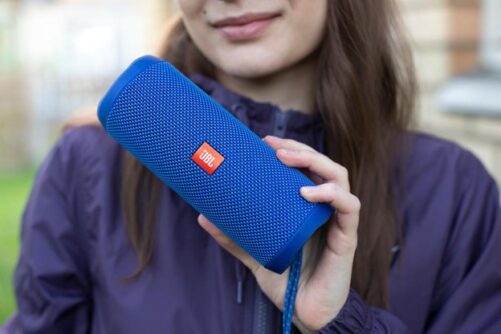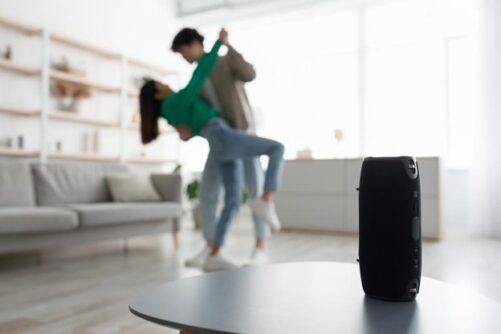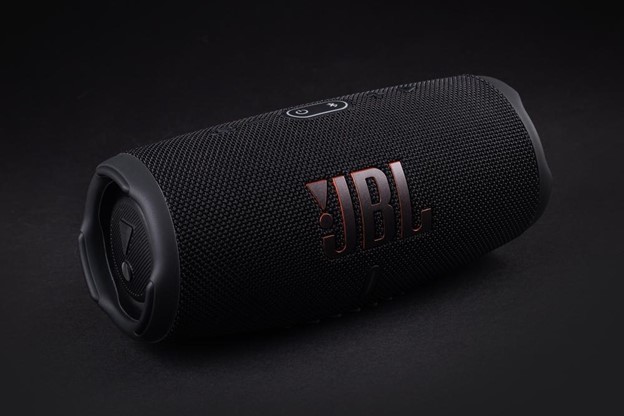You’ve finally taken the plunge and purchased yourself a portable speaker. Congratulations, and welcome to a world where you can enjoy your favorite songs any time!
You’ve charged it, connected your phone, opened your music app, and hit play.
Your expectations for sound quality are high, but something just isn’t right. You may not be an audiophile per se, but you can tell that your music can and should sound better. Maybe it’s a bit tinny, hollow sounding, distorted, or warped.
Whatever the case, it is disappointing when the sound quality of your new wireless Bluetooth speaker does not meet your expectations.
Fortunately, you can fix many of these issues by playing around with your speaker’s equalizer settings. If you find yourself in a similar predicament, we can help you determine the best equalizer settings for some of the premier JBL speakers, including the JBL Charge 5, JBL Flip 6, and JBL Xtreme 3.
Let’s get started.

Why Are JBL Speakers So Popular?
To start, JBL has been around forever – 70 years, to be exact.
James Bullogh Lansing, the company’s namesake, opened JBL Sound in 1946 and supplied parts to radio set manufacturers. As the company matured, JBL expanded into the music industry and formed partnerships with Fender Guitars and prominent recording studios.
In the 1980s, JBL introduced its home sound system models and has spent much of its time and resources perfecting them. The rest, as they say, is history.
If you ask JBL users what they like most about their products, most will point to how “sonically accurate” the speakers are, their ease of use, and consistency across all mediums. JBL speakers produce quality results whether you’re using their speakers in restaurants, at home, or on the go.
What Are Equalizer Settings Anyways?
Every ear hears music a bit differently than the next. People may also have different audio preferences when listening to their favorite tunes. An equalizer (EQ) allows you to refine audio settings to suit your ear.
Essentially, EQ is a filter that isolates specific frequencies. You can adjust these frequencies through EQ to boost, lower, or leave them unchanged. This allows you to customize your sound by emphasizing specific frequencies over others.
If you love a heavy, booming bass, EQ will enable you to boost it, so the speakers seem to vibrate with every riff. Want to isolate a vocal track? EQ can do that too.
How Do I Access My JBL Speaker’s EQ Settings?
What was that line from the old commercials? There’s an app for that…
It’s true. The JBL app works with most of its wireless devices.
Once you download the JBL app from the app store, connect your device, and begin to explore, you’ll notice a tab for Equalizer Settings along the bottom navigation.
In this tab, you can either work with the suggested presets or adjust the EQ settings on your own. Presets may be a fun place to start, as JBL has curated sound recommendations from famous DJs like Armin Van Buuren.
If you prefer to adjust the EQ on your own, a handy audio graph will allow you to adjust the bass, mid, and treble settings with a simple slide of your finger.
*It’s important to note that older generations of JBL portables — such as the Flip 4, Charge 3, etc. — do not have equalizers included. For those speakers, you will need to add a third-party equalizer app on your audio source device (usually, your phone).
What Are the Best EQ Settings For JBL Charge 5?
Pretty much every review of the JBL Charge 5 points out how loud this little JBL portable speaker is. Most say that the quality of sound, regardless of where you stand or how far away (like up to 90 feet away!), is excellent all around.
Users suggest that the JBL Charge 5 does not sacrifice the quieter melodies essential to any layered listening experience despite its volume. While the suggested presets may work just fine for some people, others may be tweaking the experience slightly.
Some users have pointed out that the JBL Charge 5 has a relatively small woofer (the component designed to produce low-frequency sounds like bass). Because of this, the JBL Charge 5 can sometimes feel like it lacks “guts” upon first listen.
If you prefer your sounds to feel rich and heavy, then consider the following EQ settings:
– Bass +1, mid -1, treble +/-0
Increasing the bass setting by one usually produces the desired effect without introducing too much distortion. In many opinions, increasing the bass beyond this state may negatively impact the sound quality by exceeding the limitations of the Charge 5 woofer’s ability.
There is another setting you may opt to try out with your JBL Charge 5, which can produce similar results:
– Bass +/- 0, mid -2, treble +/-0
This alternate sound profile allows mid-range sounds to come through clearly without sacrificing the volume and quality of bass and treble.
A hot tip for this setting: if you’re looking for more “oomph,” try setting the speaker right up against a wall. The acoustics created from this set-up produce a more natural bass response without playing around with your EQ settings.
What Are The Best EQ Settings For JBL Flip 6?
Compared to the Charge 5, the JBL Flip 6 is a smaller, more portable wireless speaker system. Most reviewers note that the Charge 5 is slightly louder than the Flip 6, though this doesn’t make a noticeable difference in sound quality.
Regarding construction, the JBL Flip 6 has a passive bass radiator on both ends, which surrounds the tweeter and driver in the middle.
Regarding EQ settings, there are two profiles you can start with. If you’re running your JBL portable speaker at less than 75% volume, try the following settings:
– Bass +2, mid +/-0, treble -1
By increasing the bass by 2 points and decreasing the treble, this setting boosts your ear’s perception of bass without warping the sound quality overall.
If you’re listening to your JBL Flip 6 at greater than 75% volume, try the following EQ setting:
– Bass +2, mid +/-0, treble -2
Again, this setting will keep the song’s guts intact without compromising vocal quality, so feel free to crank the JBL Flip 6 and see what this speaker is capable of.
What Are The Best EQ Settings For JBL Xtreme 3?
Meet the mack-daddy of JBL’s speaker line-up: the JBL Xtreme 3. Reviewers of this speaker note that it is extremely loud but not extremely portable – it weighs about six pounds, after all.
If you’re considering this speaker, you may want to consider your end-use. It may not be the one you plan on taking with you. However, if you intend to keep this JBL speaker in one or two places in your home, like a family room or office, this may be the one for you.
Like the JBL Flip 6, the Xtreme 3 has passive bass radiators on both ends with the main drivers in the middle. The Xtreme 3 is more ruggedly durable than other options and will survive being submerged in water or a fall from counter height.
For the best EQ settings for the Xtreme 3, we can recommend the following:
– Bass +2, mid +/-0, treble +1
Most users agree that the Xtreme 3 doesn’t produce the best bass sounds for the price, leaving your music sounding relatively hollow. By boosting the bass +2, you can experience a fuller sound at even the highest volume.

Should EQ Settings Be Adjusted Based On The Type Of Music You Listen To?
There are two schools of thought when it comes to answering this question.
Some would argue that once you have established an EQ setting that is pleasing to your ear, you can continue to use this same setting regardless of the genre you’re listening to. Those same people may suggest that EQ settings address deficiencies within the unit, so once you’ve worked out the kinks, there’s no need to revisit it.
Another group suggests that EQ settings are meant to be adjusted with each genre of music. For instance, if you’re a big fan of rock music, you may up the bass and treble while keeping the mid-flat for a classic “V” shaped setting. You may up the treble for voice clarity if you’re a podcast listener.
You don’t have to be an audiophile to adjust your EQ settings based on the genre of music because the end result is the same: EQ settings are best when they sound best to you.
I’ve Adjusted My EQ Settings, But I Still Don’t Like The Sound. What’s Next?
If you’ve played with your EQ and are still unhappy with the sound quality, there is another step you may want to try. Many devices and certain music streaming services have equalizer settings. For instance, you can adjust EQ settings on an iPhone under Settings > Music > EQ.
In Spotify, you can adjust the EQ settings in the app by tapping the gear icon, selecting “playback,” and choosing “equalizer.” Adjusting the settings in your device or your streaming service can also positively or negatively impact the sound of your wireless device. So, feel free to play around!
Final Thoughts
Indeed, the best equalizer settings for the JBL Charge 5, JBL Flip 6, and JBL Xtreme 3 are largely subjective to each user.
As mentioned, all individuals perceive sound differently. Some are sensitive to bass, while others have difficulty hearing voices clearly. The settings mentioned above provide an excellent starting point for enjoying the full potential of your JBL wireless speaker.
Happy listening!

